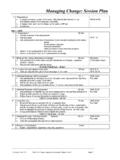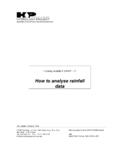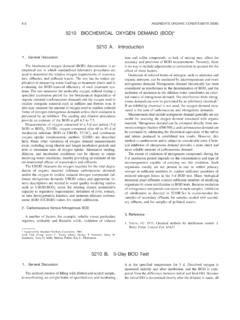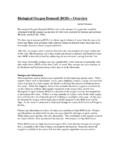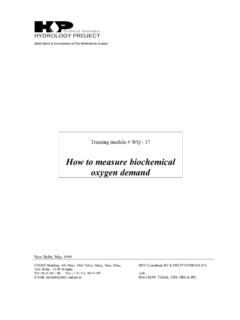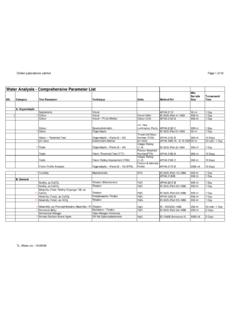Transcription of Understanding biochemical oxygen demand test - CWC
1 World Bank & Government of The Netherlands fundedTraining module # WQ - 15 Understanding biochemicaloxygen demand testNew Delhi, May 1999 CSMRS Building, 4th Floor, Olof Palme Marg, Hauz Khas,New Delhi 11 00 16 IndiaTel: 68 61 681 / 84 Fax: (+ 91 11) 68 61 685E-Mail: Consultants BV & DELFT HYDRAULICS withHALCROW, TAHAL, CES, ORG & JPSH ydrology Project Training Module File: 15 Understanding BOD Version 05/11/02 Page 1 Table of contentsPage1 Module context22 Module profile33 Session plan44 Overhead/flipchart master55 Evaluation sheets216 Handout237 Additional handout288 Main text30 Hydrology Project Training Module File: 15 Understanding BOD Version 05/11/02 Page 21. Module contextThis module deals with significance and Understanding of biochemical oxygen demandmeasurement. Modules in which prior training is required to complete this modulesuccessfully and other available, related modules in this category are listed in the designing a training course, the relationship between this module and the others, wouldbe maintained by keeping them close together in the syllabus and place them in a logicalsequence.
2 The actual selection of the topics and the depth of training would, of course,depend on the training needs of the participants, their knowledge level and skillsperformance upon the start of the titleCodeObjectives1 Basic water quality conceptsWQ - 01 Become familiar with common waterquality parameters. Appreciate important water chemistry conceptsWQ - 02 Convert units from one to another Understand the basic concepts ofquantitative chemistry Report analytical results with thecorrect number of significant digits3 How to prepare standardsolutions aWQ - 04 Recognise different types ofglassware Use an analytical balance andmaintain it. Prepare standard solutions4 Understanding the chemistryof dissolved oxygenmeasurementaWQ - 11 Appreciate significance of DOmeasurement Understand the chemistry of DOmeasurement by Winkler method5 How to measure dissolvedoxygen (DO)aWQ - 12 Measure dissolved oxygen in watersamples6 Understanding dilution andseeding procedures in BODtestWQ - 16 Understand the need and procedurefor dilution and seeding in BODmeasurement7 Understanding chemicaloxygen demand testWQ - 18 Appreciate significance of CODmeasurement Understand the chemistry of CODmeasurementa prerequisiteHydrology Project Training Module File: 15 Understanding BOD Version 05/11/02 Page 32.
3 Module profileTitle: Understanding biochemical oxygen demand testTarget group:HIS function(s): Q1, Q2, Q3, Q5 Duration:1 session of 75 minObjectives:After the training the participants will be able to: Understand the significance and theory of BOD measurementKey concepts: Significance BIS procedure BOD progressionTraining methods:Lecture, exercises and open discussionTraining toolsrequired:OHSH andouts:As provided in this moduleFurther readingand references: Analytical Chemistry: An introduction, Skoog and D. Saunders College Publishing Chemistry for Environmental Engineering, Sawyer, and Parkin. McGraw-Hill, 1994 Hydrology Project Training Module File: 15 Understanding BOD Version 05/11/02 Page 43. Session planNoActivitiesTimeTools1 Preparations2 Introduction: Ask participants to name some biochemical reactions Emphasise the role of the living agency Describe the content of the lecture Discuss significance of BOD test15 minOHS3 BOD progression Describe BOD progression curve Explain how it can be measured15 minOHSOHS4 BIS procedure Explain the difference between the standard and BISprocedures5 minOHS5 Relation to other parameters Explain the difference and relation between BOD andother parameters5 minOHS6 Errors and interferences Discuss the need for standardisation of the procedure10 minOHS7 BOD progression formulae Explain first order reaction Explain calculation procedure using simplifiedapproach and exponential function20 minOHS8 Conclusion Recapitulate significance of the test5 minHydrology Project Training Module File: 15 Understanding BOD Version 05/11/02 Page 54.
4 Overhead/flipchart masterOHS format guidelinesType of textStyleSettingHeadings:OHS-TitleArial 30-36, with bottom border line (not:underline)Text:OHS-lev1 OHS-lev2 Arial 24-26, maximum two levelsCase:Sentence case. Avoid full text in :Use occasionally and in a consistent wayListings:OHS-lev1 OHS-lev1-NumberedBig for definite series of steps. Avoidroman numbers and :None, as these get lost in photocopying andsome colours do not reproduce at of a table will ease horizontal alignmentover more lines (columns)Use equation editor for advanced formattingonlyHydrology Project Training Module File: 15 Understanding BOD Version 05/11/02 Page 6 biochemical oxygen Demand1. Significance2. BIS procedure3. Relation to other parameters4. Errors & interferences5. BOD equationHydrology Project Training Module File: 15 Understanding BOD Version 05/11/02 Page 7 Significance biochemical reaction Measures oxygen equivalence of aggregate organic matter micro-organisms Organic matter + O2 H2O + CO2 Measures water pollution potential Depletion of DO adversely affects aquatic ecologyHydrology Project Training Module File: 15 Understanding BOD Version 05/11/02 Page 80123456789051015 Time (days)BOD (mgO2/L)Sample 1 Ultimate BODS ample 2 oxygen uptake curvesHydrology Project Training Module File: 15 Understanding BOD Version 05/11/02 Page 9 BOD progression reaction requires time nearly 20 days to exert ultimate BOD rate depends on: organic matter, micro-organisms temperature faster at the beginning, then slows down only bio-degradable organic matter is oxidisedHydrology Project Training Module File.
5 15 Understanding BOD Version 05/11/02 Page 10 BOD progression: example20oC27oCDayDO,mg/L Consumed DO,mg/L Project Training Module File: 15 Understanding BOD Version 05/11/02 Page 11 BIS procedure Standard methods: 5 day, 20oC BIS: 3 day, 27oC Incubation temperature of 27oC is easier to maintain Result available earlierHydrology Project Training Module File: 15 Understanding BOD Version 05/11/02 Page 12 Other parameters for organic matter (1) Chemical oxygen demand , COD organic matter is oxidised chemically Total organic carbon, TOC organic matter is combusted Measure both biodegradable & non-biodegradable organicmatter Reaction is completed in a few hoursHydrology Project Training Module File: 15 Understanding BOD Version 05/11/02 Page 13 Other parameters for organic matter (2) BOD measures pollution potential of decomposable organicmatter COD is always greater than BOD TOC does not measure oxygen equivalence Both COD & TOC can be related to BODH ydrology Project Training Module File: 15 Understanding BOD Version 05/11/02 Page 14 Errors & interferences (1) Organic matter is continually oxidised Preserve by cooling Extreme pH values adjust between pH & Toxic substances remove by chemical reaction if possible provide acclimated seedHydrology Project Training Module File: 15 Understanding BOD Version 05/11/02 Page 15 Errors & interferences (2) Presence of algae remove excess oxygen incubate in dark Nitrifying bacteria NH4+ + 2O2 NO3- + H2O + 2H+ if measuring only carbonaceous demand add inhibitory chemicalHydrology Project Training Module File.
6 15 Understanding BOD Version 05/11/02 Page 16 BOD progression formula (1) First order reaction oxygen demand exerted each day is a constant fraction ofthe demand remaining Example: Calculate BOD exerted in 1,2, & 3 days, if 25% of remaining BOD is oxidised each day. The ultimate BOD is 256 mg/LHydrology Project Training Module File: 15 Understanding BOD Version 05/11/02 Page 17 Example (contd)Time,dayBOD exertedeach dayCumulativeBOD = 64 0+64 = 64256-64 = = 48 64+48 = 112256-112 = = 36 112+36 = 148256-148 = 108 Hydrology Project Training Module File: 15 Understanding BOD Version 05/11/02 Page 18 BOD Equationyt = Lo (1- e -kt)yt = cumulative oxygen demand exerted in time t days, mg/lLo= ultimate BOD, mg/Lk = BOD rate constant, per dayHydrology Project Training Module File: 15 Understanding BOD Version 05/11/02 Page 19 BOD rate constant characteristics of waste microbial population temperaturek1 = k2 (T1-T2) k1 & k2 are rate constants at temperatures T1 & T2, respectivelyHydrology Project Training Module File.
7 15 Understanding BOD Version 05/11/02 Page 20 BOD progression0123456789100123456 Time, daysOxygen consumed, mg/Lk,27oC = ,20oC Project Training Module File: 15 Understanding BOD Version 05/11/02 Page 215. Evaluation sheetsHydrology Project Training Module File: 15 Understanding BOD Version 05/11/02 Page 22 Hydrology Project Training Module File: 15 Understanding BOD Version 05/11/02 Page 236. HandoutHydrology Project Training Module File: 15 Understanding BOD Version 05/11/02 Page 24 biochemical oxygen Demand1. Significance2. BIS procedure3. Relation to other parameters4. Errors & interferences5. BOD equationSignificance biochemical reaction Measures oxygen equivalence of aggregate organic matter micro-organisms Organic matter + O2 H2O + CO2 Measures water pollution potential Depletion of DO adversely affects aquatic ecologyBOD progression reaction requires time nearly 20 days to exert ultimate BOD rate depends on: organic matter, micro-organisms temperature faster at the beginning, then slows down only bio-degradable organic matter is oxidisedBOD progression: example20oC27oCDayDO,mg/LConsumedDO, Project Training Module File: 15 Understanding BOD Version 05/11/02 Page 25 BIS procedure Standard methods: 5 day, 20oC BIS.
8 3 day, 27oC Incubation temperature of 27oC is easier to maintain Result available earlierOther parameters for organic matter (1) Chemical oxygen demand , COD organic matter is oxidised chemically Total organic carbon, TOC organic matter is combusted Measure both biodegradable & non-biodegradable organic matter Reaction is completed in a few hoursOther parameters for organic matter (2) BOD measures pollution potential of decomposable organic matter COD is always greater than BOD TOC does not measure oxygen equivalence Both COD & TOC can be related to BODE rrors & interferences (1) Organic matter is continually oxidised Preserve by cooling Extreme pH values adjust between pH & Toxic substances remove by chemical reaction if possible provide acclimated seedErrors & interferences (2) Presence of algae remove excess oxygen incubate in dark Nitrifying bacteria NH4+ + 2O2 NO3- + H2O + 2H+ if measuring only carbonaceous demand add inhibitory chemicalHydrology Project Training Module File: 15 Understanding BOD Version 05/11/02 Page 26 BOD progression formula (1) First order reaction oxygen demand exerted each day is a constant fraction of the demand remaining Example: Calculate BOD exerted in 1,2, & 3 days, if 25% of remaining BOD is oxidised each day.
9 The ultimate BOD is 256 mg/LExample (contd)Time, day BOD exerted each dayCumulative BOD exerted BOD = 640+64 = 64256-64 = = 4864+48 = 112256-112 = = 36112+36 = 148256-148 = 108 BOD Equationyt = Lo (1- e -kt)yt = cumulative oxygen demand exerted in time t days, mg/lLo= ultimate BOD, mg/Lk = BOD rate constant, per dayBOD rate constant characteristics of waste microbial population temperaturek1 = k2 (T1-T2)k1 & k2 are rate constants at temperatures T1 & T2, respectivelyHydrology Project Training Module File: 15 Understanding BOD Version 05/11/02 Page 27 Add copy of Main text in chapter 8, for all Project Training Module File: 15 Understanding BOD Version 05/11/02 Page 287. Additional handoutThese handouts are distributed during delivery and contain test questions, answers toquestions, special worksheets, optional information, and other matters you would not like tobe seen in the regular is a good practice to pre-punch these additional handouts, so the participants can easilyinsert them in the main handout Project Training Module File: 15 Understanding BOD Version 05/11/02 Page 29 Hydrology Project Training Module File: 15 Understanding BOD Version 05/11/02 Page 308.
10 Main BOD Affecting the oxygen of BOD to Other WaterQuality Progression Project Training Module File: 15 Understanding BOD Version 05/11/02 Page 1 Understanding biochemical oxygen demand test1. IntroductionThe biochemical oxygen demand (BOD) test is an experimentally derived analytical methoddesigned to give an indication of the polluting nature of organic matter in a sample of measures aggregate organic matter. How this is achieved is described organic polluting matter is discharged to the aquatic environment it will normallydegrade through the action of micro-organisms in the watercourse. In degrading the organicmatter, micro-organisms take up atmospheric oxygen which is dissolved in the water. Suchan uptake of dissolved oxygen (called an oxygen demand ) can, if sufficient oxygen is lost,lead to the degradation of water quality as aquatic plants and animals (including fish) need tobreathe this dissolved gas and will die or migrate if it is unavailable.


